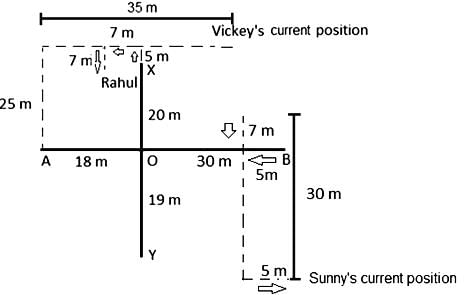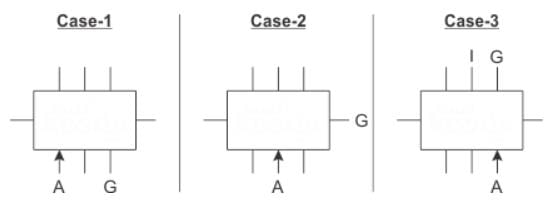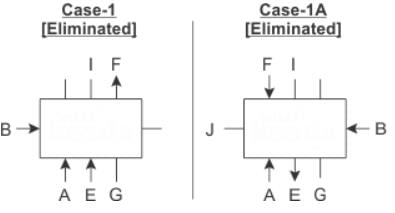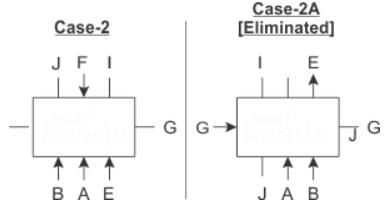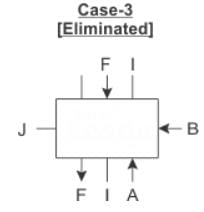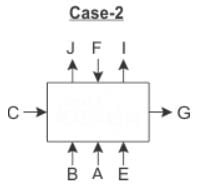SSC GD Constable Mock Test - 7 - SSC MTS / SSC GD MCQ
30 Questions MCQ Test - SSC GD Constable Mock Test - 7
Directions to Solve
In each of the following questions, five words have been given out of which four are alike in some manner, while the fifth one is different. Choose the word which is different from the rest.
Question -
Choose the word which is different from the rest.
Directions: Study the following information and answer the question given below it.
There is an XY axis in such a way that X is in north and Y is in south direction. There is an AB axis in such a way that A is in west direction and B is in east direction. AB axis and XY axis intersect at a point O in such a way that XO is 20 m, OY is 19 m, OA is 18 m and OB is 30 m. Sunny starts from point B and walks 5 m towards west, then turns to his right and walks 7 m, then walks 30 m in south direction, and finally turns to his left and walks 5 m. Vickey starts from point A and walks 25 m in north direction, and then turns right and walks 35 m in east direction. Rahul starts from point X and walks 5 m in north direction, then turns to his left and walks 7 m, and again turns to his left and walks 7 m.
Q. Point Y is in which direction with respect to Sunny's current position?
Direction : Study the following question carefully and choose the right answer.
Q: If EARTH can be coded as ‘IUSBF’ how can GLOBE be coded?
Directions: Read the following information carefully and answer the questions given beside.
Eight persons viz. A, B, C, E, F, G, I and J sit around a rectangular table such that three persons sit on each longer side and one person sits on each shorter side. Nobody sits at the corners. The persons whose name starts with vowel do not sit on the shorter side of the table. Three of them face away from centre while the rest five face towards the centre.
B, who faces centre sits second to the left of E. J is on the immediate right of F, who is at a gap of two persons from E. Neither C nor A face away from centre. The immediate neighbors of F face away from centre. G is second to the right of A. I is on the immediate left of F. I is neither adjacent to A nor to C. E is adjacent to G.
Q. Which of the following statements is true?
What is the rate of simple interest for the first 4 years if the sum of Rs. 360 becomes Rs. 540 in 9 years and the rate of interest for the last 5 years is 6%?
Vinod makes a deposit of Rs. 100,000 in Syndicate Bank for a period of 2 years. If the rate of interest be 12% per annum compounded half-yearly, what amount will he get after 2 years?
Raju can do 25% of a piece of work in 5 days. How many days will he take to complete the work ten times?
The sum of two even numbers is six more than twice of the smaller number. If the difference between these two numbers is 6, If the larger number lies between 15 to 25 Which is the smaller number?
A number is divided by 2, 3, 4, 5 or 6, reminder in each case is one. But the number is exactly divisible by 7. The number lies between 250 and 350, the sum of digits of the number will be
Find the last number which when divided by 6, 8, 15 and 30 leaves remainder 2, 4, 11 and 26 respectively?
When the price of rice is increased by 30 percent, a family reduces its consumption such that the expenditure is only 20 percent more than before. If 50 kg of rice is consumed by family before, then find the new consumption of family (approx.)
Brian and Sam are two brothers who work at a multinational company in the New York City. The ratio of monthly incomes of Brian and Sam is 3 : 4 and the ratio of their monthly savings is 2 : 3, respectively. It is known that Brian spends two-thirds of his income each month. Find the respective ratio of their monthly expenditures.
Gopal, a cunning milkman, buys milk from Frontier Dairy Junction and sells it to gullible housewives. He buys milk at Rs. 35 per litre and adds 250 ml of pure water to a litre of the thick creamy milk. He sells the mixture so formed at Rs. 45 per litre. What is his approximate profit percentage? It is to be assumed that it costs him next to nothing to mix the milk in water.
In the context of the Indian freedom struggle, 16th October 1905 is well known for which one of the following reasons?
Consider the following statements:
The Cripps Proposals include the provision for
- Full independence for India.
- Creation of Constitution-making body.
Which of the statements given above is/are correct?
Which of the following countries won the final of the triangular cricket series held in durban in februarry 1997 ?
Sensation of sound persists in our brain for about -
A body moving in a circular path with a constant speed has a -
Who recently assumed charge as the Punjab Chief Secretary?
Where was the 17th Indian Cooperative Congress inaugurated?
In the following questions four alternatives are given for the idiom/phrase italicised and underlined in the sentence. Choose the alternative which best expresses the meaning of idiom/phrase.
Q. I did not mind what he was saying, he was only through his hat.
The CEO has proposed a new policy requiring that employees should retain all pensions indefinitely or be allowed to cash them in at retirement.
The recently discovered notes of the writer suddenly revealed that this most timidand shy of women was an intellectual giant guided in both emotional and spiritualactivities by a sharp sense of moral courage.
Directions: Four statements are given below. Among these, four statements are in logical order and form a coherent paragraph/passage. From the given options, choose the option that does not fit into the theme of the passage.
The active voice sentence "The teacher will grade the papers tomorrow" can be changed to passive voice as:
Direction: Read the following passage carefully and answer the question that follows.
After a worrying pre-monsoon phase between March and May, when rainfall was scarce, the current robust season in most parts of coastal, western and central India augurs well for the entire economy. Aided apparently by beneficial conditions in the Indian Ocean, very heavy rainfall has been recorded, notably in Maharashtra, Gujarat, Rajasthan, the northeastern States, Karnataka, the Konkan coast, hilly districts of Kerala and Tamil Nadu. This pattern may extend into Chhattisgarh, Odisha, Bengal and other eastern regions. A normal Indian Summer Monsoon is bountiful overall, but as last year’s flooding in Kerala, and the Chennai catastrophe of 2015 showed, there can be a terrible cost in terms of lives and property lost, and people displaced. Distressing scenes of death and destruction are again being witnessed. Even in a rain-shadow region such as Coimbatore in Tamil Nadu, the collapse of a railway parcel office after a downpour has led to avoidable deaths. What this underscores is the need to prepare for the rainy season with harvesting measures, as advocated by the Centre’s Jal Shakti Abhiyan, and a safety audit of structures, particularly those used by the official agencies. In drafting their management plans, States must be aware of the scientific consensus: that future rain spells may be short, often unpredictable and very heavy influenced by a changing climate. They need to invest in reliable infrastructure to mitigate the impact of flooding and avert disasters that could have global consequences in an integrated economy.
The long-term trends for flood impact in India have been one of declining loss of lives and cattle since the decadal high of 1971-80, but rising absolute economic losses, though not as a share of GDP. It is important, therefore, to increase resilience through planning, especially in cities and towns which are expanding steadily. Orderly urban development is critical for sustainability, as the mega flood disasters in Mumbai and Chennai witnessed in this century make clear. It is worth pointing out that the response of State governments to the imperative is tardy and even indifferent. They are hesitant to act against encroachment of lake catchments, river courses and floodplains. The extreme distress in Chennai, for instance, has not persuaded the State government against allowing structures such as a police station being constructed on a lake bed, after reclassification of land. Granting such permissions is an abdication of responsibility and a violation of National Disaster Management Authority Guidelines to prevent urban flooding. As a nation that is set to become the most populous in less than a decade, India must address its crippling cycles of drought and flood with redoubled vigour. Scientific hydrology, coupled with the traditional wisdom of saving water through large innovative structures, will mitigate floods and help communities prosper.
Q. Which among the following is correct regarding the pattern of rainfall in the future as declared by the scientific community?
Direction: Read the following passage carefully and answer the question that follows.
After a worrying pre-monsoon phase between March and May, when rainfall was scarce, the current robust season in most parts of coastal, western and central India augurs well for the entire economy. Aided apparently by beneficial conditions in the Indian Ocean, very heavy rainfall has been recorded, notably in Maharashtra, Gujarat, Rajasthan, the northeastern States, Karnataka, the Konkan coast, hilly districts of Kerala and Tamil Nadu. This pattern may extend into Chhattisgarh, Odisha, Bengal and other eastern regions. A normal Indian Summer Monsoon is bountiful overall, but as last year’s flooding in Kerala, and the Chennai catastrophe of 2015 showed, there can be a terrible cost in terms of lives and property lost, and people displaced. Distressing scenes of death and destruction are again being witnessed. Even in a rain-shadow region such as Coimbatore in Tamil Nadu, the collapse of a railway parcel office after a downpour has led to avoidable deaths. What this underscores is the need to prepare for the rainy season with harvesting measures, as advocated by the Centre’s Jal Shakti Abhiyan, and a safety audit of structures, particularly those used by the official agencies. In drafting their management plans, States must be aware of the scientific consensus: that future rain spells may be short, often unpredictable and very heavy influenced by a changing climate. They need to invest in reliable infrastructure to mitigate the impact of flooding and avert disasters that could have global consequences in an integrated economy.
The long-term trends for flood impact in India have been one of declining loss of lives and cattle since the decadal high of 1971-80, but rising absolute economic losses, though not as a share of GDP. It is important, therefore, to increase resilience through planning, especially in cities and towns which are expanding steadily. Orderly urban development is critical for sustainability, as the mega flood disasters in Mumbai and Chennai witnessed in this century make clear. It is worth pointing out that the response of State governments to the imperative is tardy and even indifferent. They are hesitant to act against encroachment of lake catchments, river courses and floodplains. The extreme distress in Chennai, for instance, has not persuaded the State government against allowing structures such as a police station being constructed on a lake bed, after reclassification of land. Granting such permissions is an abdication of responsibility and a violation of National Disaster Management Authority Guidelines to prevent urban flooding. As a nation that is set to become the most populous in less than a decade, India must address its crippling cycles of drought and flood with redoubled vigour. Scientific hydrology, coupled with the traditional wisdom of saving water through large innovative structures, will mitigate floods and help communities prosper.
Q. Which among the following is correct regarding the impact of flood in India over the years starting from 1970s?


